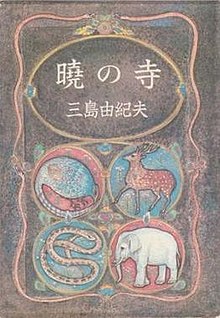The Temple of Dawn

First edition (Japanese)
|
|
| Author | Yukio Mishima |
|---|---|
| Original title |
Akatsuki no Tera 暁の寺 |
| Translator | E. Dale Saunders & Cecilia Segawa Seigle |
| Country | Japan |
| Language | Japanese |
| Series | The Sea of Fertility |
| Publisher | Shinchosha (orig.) & Alfred A. Knopf (Eng. trans.) |
|
Publication date
|
1970 |
|
Published in English
|
Oct 1973 |
| Media type | Print (Hardback & Paperback) |
| ISBN | (Eng. trans. first edition, hardback) |
| OCLC | 628303 |
| 895.6/3/5 | |
| LC Class | PZ3.M6878 Se vol. 3 PL833.I7 |
| Preceded by | Runaway Horses |
| Followed by | The Decay of the Angel |
The Temple of Dawn (暁の寺 Akatsuki no Tera) is the third novel in the Sea of Fertility tetralogy by the Japanese writer Yukio Mishima. For this as for the other novels in the series, Mishima travelled to various places to conduct research, including Wat Arun in Bangkok, Thailand.
The lawyer Honda visits Thailand on a business trip and encounters a young girl whom he believes to be his schoolfriend's second reincarnation. Eleven years later she travels to Japan to study and he befriends her in the hope of learning more. The main narrative takes place between 1941 and 1952. The last chapter is set in 1967.
In 1941, Shigekuni Honda is sent to Bangkok as legal counsel for Itsui Products in a case involving a spoilt shipment of antipyretic drugs. He takes advantage of the trip to see as much as he can of Thailand.
After touring many great buildings, he visits the Temple of Dawn and is deeply impressed by its sumptuous architecture, which to the sober lawyer represents "golden listlessness", the luxurious feel of anti-rationalism and of "the constant evasion of any organized logical system". Mentioning to his translator, Hishikawa, that he went to school with two Siamese princes (Pattanadid, a younger brother of Rama VI, and his cousin Kridsada, a grandson of Rama IV—both in Lausanne with their uncle Rama VIII), a short meeting is arranged with Pattanadid's seven-year-old daughter, Princess Chantrapa (Ying Chan), who claims to be the reincarnation of a Japanese boy, much to the embarrassment of her relatives, who keep her isolated in the Rosette Palace.
Ying Chan almost immediately claims to recognise Honda, asserts that she is Isao and demands to be taken back to Japan with him. Honda questions her and satisfies himself that she is the genuine article, but is bothered at a later meeting by the absence of the three moles that helped him identify Isao.
...
Wikipedia
